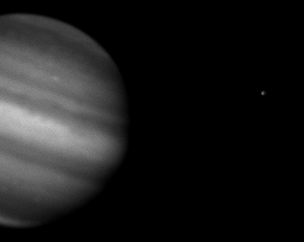October 10, 1999 Occultation of a star by Jupiter
observers: W.Hubbard, R.Hill
This was an occultation of 7.8-mag. SAO 92746 (=HIP 9369=PPM 117863) by the north polar region of Jupiter on Sunday morning, October 10th, visible throughout the Western Hemisphere, including the Americas, Hawaii, and the Azores. The star was spectral type K7, so observation was in the methane absorption band at 8900 Anstrom units which considerably darkened the planet.
Here is a view of the occultation of a star by Jupiter on Saturday, October 9, as viewed from the 1.54m telescope at Catalina Station near Tucson. We are looking at an image of Jupiter in a methane filter at a wavelength of 0.89 micrometers. The image appears bright where there are higher clouds in Jupiter's atmosphere and therefore less methane to absorb the reflected sunlight.

A view of the star approaching Jupiter. This image was made at 9:35 pm on Saturday night, 9 October 1999, that is, about 25 minutes after the previous one. Notice how much Jupiter has rotated. The star can be seen to the right. It will go behind the north pole of Jupiter about two hours later.

Below is the occultation of a star by Jupiter on 10 October 1999 (Universal Time) The star is 7 million AU from Earth.It is setting behind Jupiter's north polar atmosphere at a distance of 4 AU from Earth. The bright flashes are caused by atmospheric waves in Jupiter's atmosphere. The time that it takes the star to disappear will tell us the scale height in this part of Jupiter's atmosphere. It is possible that we will see a large scale height because this region may be heated by Jupiter's aurorae.This movie starts at 11:32:59 pm on Saturday night, October 9, and covers a time interval of 13 minutes and 20 seconds at 5 frames per second.




